What is better during the Coronavirus Pandemic? (Or any time)
We may be social distancing, but we still have to eat. On one hand, supporting local restaurants, cafes and coffee shops is so much more important now than ever before. But on the other hand, you may be worried about the safety of to-go orders. The truth is, no type of shopping is currently hazard free, but the risks of not eating far outweigh the risks of what would happen otherwise. Here are a few tips on how to stay as safe as possible AND get the yummiest food available:
1) Pick Carefully:
Stick to restaurants that you know well, and that have been awarded top ratings from your local health department. The FDA states there is no evidence of coronavirus being spread by food, but a general rule of thumb ordering cooked food is your best bet. Cooked food is cleared of any virus (COVID-19 or other) that it potentially had in it before it was cooked.

2) Avoid Human Contact:
For Delivery: It’s believed the riskiest factor currently is coming into contact with the courier. If you’re getting food delivered, ask the deliverer to leave it outside your door (instead of face to face) and wait till they’re gone to pick it up. Also, tip electronically instead of using cash to prevent contact.
For Pick Up: When placing the order, ask if you can pay ahead of time via phone to limit personal interactions that come with paying in person. Some restaurants and fast food chains have apps you can do it all in a few clicks from your phone! When entering the store to pick up your food, it’s recommended to wear a fabric face mask even if you’re not sick or showing symptoms.
Pro tip: if you’re able, consider a larger tip than your usual to make up for all the revenue lost during this time, and the courier’s travel during this risky period
3) Disregard Packaging:
After unpacking and plating your food, discard the packaging, sanitize surfaces it was on, and wash your hands before eating.
4) Go compostable:
According to the World Economic Forum, coronavirus lives longer on hard shiny surfaces (such as plastic cutlery) than porous surfaces (like TwentyFifty forks and spoons). Porous surfaces are much less likely to hold viable amounts of the virus, so when you order your food ask for no cutlery and replace with TwentyFifty. Not only can you take it with you if you’re eating on the run (for example, if you’re still working an essential job or are part of the service industry yourself), but you can also compost it in your home garden when you’re done.

5) Avoid Ordering Crispy or Crunchy Dishes:
As much as we may be craving your favorite gourmet grilled cheese or drool-worthy french fries, chances are those textures will end up soggy during transport. Also avoid anything that involves hot and cold elements as the end result will probably just be a kind-of-warm mess by the time you’re ready to eat. Stick to softer textures (such as curries) and eat as soon as possible after pick up.
With a bit of luck, our Nation will come together to Flatten the Curve, but in the meantime, support local as much as possible and don’t forget to go compostable!

